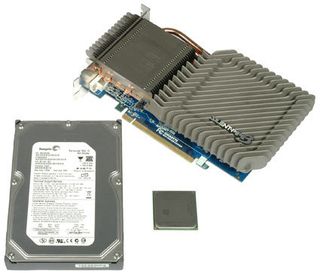Is Your PC Ready for a System Update?
Upgrade Considerations

We created three upgrade options: one for as little as $200, the second for $350, and the last for as much as $500. This photo shows the medium upgrade, which replaces the processor, the hard drive and the graphics card.
Knowing that the entry price for a new system is approximately $600, we suggest that you not spend more than $500. Ideally, your upgrade should be considerably cheaper, while still providing a noticeable impact on performance. The whole idea is to bring the two-year old single core PC to a technical level at which it can serve for at least the next 12 months, until both AMD and Intel have released their native quad core processors, together with the appropriate platforms. Note that every Intel platform that doesn't run on the 945 chipset family or higher will require you to replace the motherboard.
AMD will switch to another socket with 940 pins called AM3. It will run HyperTransport 3.0 and mainly enable the transition to DDR3 memory, while remaining pin-compatible with DDR2. Intel is working on the successor to the current Core microarchitecture, code named Nehalem, scheduled for H2/2008. It will force users to switch from Socket 775 to Socket H (LGA, 715 pins). The same architecture is expected to be ready to run with an integrated memory controller in the server space on Socket B (LGA, 1336 pins), which could be adopted for high-end desktops if needed. Since new processors and new features will be available, this will be the next attractive opportunity to exchange your entire PC.
Until then, we decided to approach our upgrade project with three different budgets in mind: $200, $350 and $500. , the first simply dealing with the most important components and the last representing a full blown upgrade of most core components.
Let's look at the component options first.
Stay on the Cutting Edge
Join the experts who read Tom's Hardware for the inside track on enthusiast PC tech news — and have for over 25 years. We'll send breaking news and in-depth reviews of CPUs, GPUs, AI, maker hardware and more straight to your inbox.
Current page: Upgrade Considerations
Prev Page Our Reference System: Two Years Old Next Page ProcessorMost Popular

